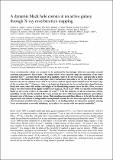| dc.contributor.author | Alston, William N. | |
| dc.contributor.author | Fabian, Andrew C. | |
| dc.contributor.author | Kara, Erin A | |
| dc.contributor.author | Parker, Michael L. | |
| dc.contributor.author | Dovciak, Michal | |
| dc.contributor.author | Pinto, Ciro | |
| dc.contributor.author | Jiang, Jiachen | |
| dc.contributor.author | Middleton, Matthew J. | |
| dc.contributor.author | Miniutti, Giovanni | |
| dc.contributor.author | Walton, Dominic J. | |
| dc.contributor.author | Wilkins, Dan R. | |
| dc.contributor.author | Buisson, Douglas J. K. | |
| dc.contributor.author | Caballero-Garcia, Maria D. | |
| dc.contributor.author | Cackett, Edward M. | |
| dc.contributor.author | De Marco, Barbara | |
| dc.contributor.author | Gallo, Luigi C. | |
| dc.contributor.author | Lohfink, Anne M. | |
| dc.contributor.author | Reynolds, Chris S. | |
| dc.contributor.author | Uttley, Phil | |
| dc.contributor.author | Young, Andrew J. | |
| dc.contributor.author | Zogbhi, Abderahmen | |
| dc.date.accessioned | 2021-01-21T22:19:37Z | |
| dc.date.available | 2021-01-21T22:19:37Z | |
| dc.date.issued | 2020-01 | |
| dc.identifier.issn | 2397-3366 | |
| dc.identifier.uri | https://hdl.handle.net/1721.1/129519 | |
| dc.description.abstract | X-ray reverberation echoes are assumed to be produced in the strongly distorted spacetime around accreting supermassive black holes. This signal allows us to spatially map the geometry of the inner accretion flow1,2—a region that cannot yet be spatially resolved by any telescope—and provides a direct measure of the black hole mass and spin. The reverberation timescale is set by the light travel path between the direct emission from a hot X-ray corona and the reprocessed emission from the inner edge of the accretion disk3–6. However, there is an inherent degeneracy in the reverberation signal between black hole mass, inner disk radius and height of the illuminating corona above the disk. Here we use a long X-ray observation of the highly variable active galaxy IRAS 13224−3809 to track the reverberation signal as the system evolves on timescales of a day7,8. With the inclusion of all the relativistic effects, modelling reveals that the height of the X-ray corona increases with increasing luminosity, providing a dynamic view of the inner accretion region. This simultaneous modelling allows us to break the inherent degeneracies and obtain an independent timing-based estimate for the mass and spin of the black hole. The uncertainty on black hole mass is comparable to the leading optical reverberation method9, making X-ray reverberation a powerful technique, particularly for sources with low optical variability10. | en_US |
| dc.language.iso | en | |
| dc.publisher | Springer Science and Business Media LLC | en_US |
| dc.relation.isversionof | http://dx.doi.org/10.1038/s41550-019-1002-x | en_US |
| dc.rights | Creative Commons Attribution-Noncommercial-Share Alike | en_US |
| dc.rights.uri | http://creativecommons.org/licenses/by-nc-sa/4.0/ | en_US |
| dc.source | arXiv | en_US |
| dc.title | A dynamic black hole corona in an active galaxy through X-ray reverberation mapping | en_US |
| dc.type | Article | en_US |
| dc.identifier.citation | Alston, William N. et al. "A dynamic black hole corona in an active galaxy through X-ray reverberation mapping." Nature Astronomy 4, 6 (January 2020): 597–602 © 2020 The Author(s) | en_US |
| dc.contributor.department | MIT Kavli Institute for Astrophysics and Space Research | en_US |
| dc.relation.journal | Nature Astronomy | en_US |
| dc.eprint.version | Author's final manuscript | en_US |
| dc.type.uri | http://purl.org/eprint/type/JournalArticle | en_US |
| eprint.status | http://purl.org/eprint/status/PeerReviewed | en_US |
| dc.date.updated | 2020-10-30T16:29:21Z | |
| dspace.orderedauthors | Alston, WN; Fabian, AC; Kara, E; Parker, ML; Dovciak, M; Pinto, C; Jiang, J; Middleton, MJ; Miniutti, G; Walton, DJ; Wilkins, DR; Buisson, DJK; Caballero-Garcia, MD; Cackett, EM; De Marco, B; Gallo, LC; Lohfink, AM; Reynolds, CS; Uttley, P; Young, AJ; Zogbhi, A | en_US |
| dspace.date.submission | 2020-10-30T16:29:31Z | |
| mit.journal.volume | 4 | en_US |
| mit.journal.issue | 6 | en_US |
| mit.license | OPEN_ACCESS_POLICY | |
| mit.metadata.status | Complete | |
